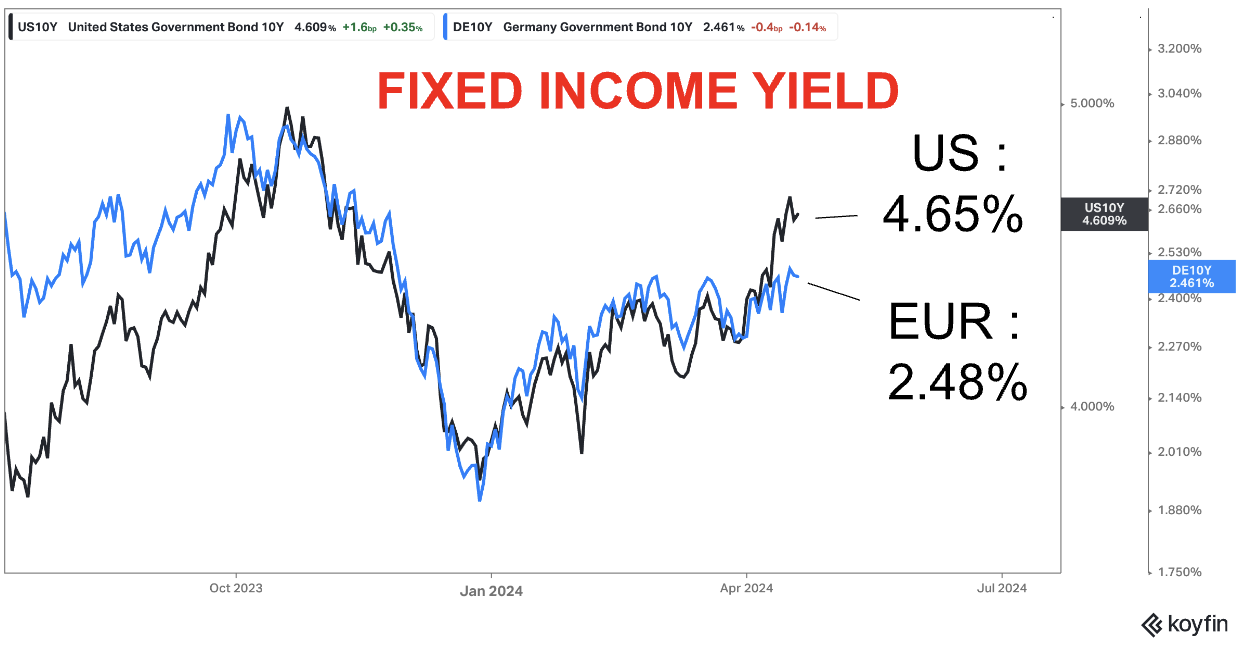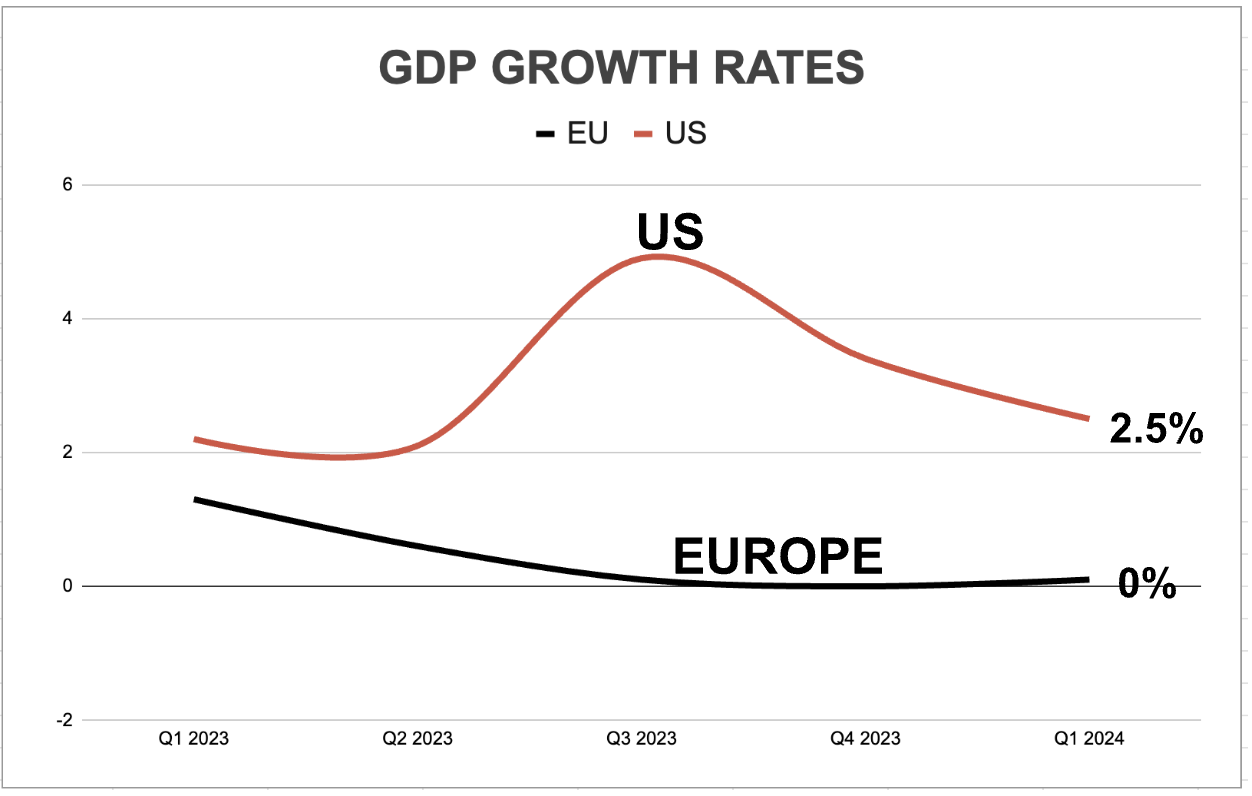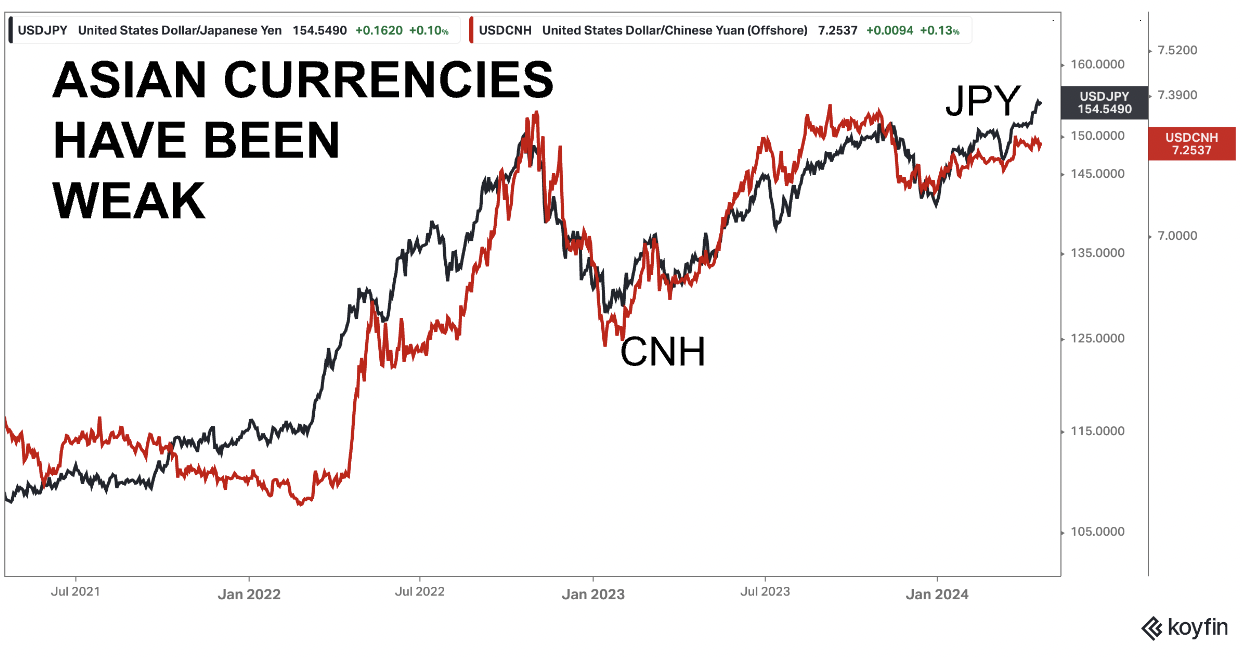I’ve been reflecting on recent macro-economic events and a number of factors now suggest that a meaningful downtrend in the Eur/Usd is underway.
Let’s begin by first discussing the ECB’s current monetary policy stance.
ECB stance
The ECB has been explicitly dovish in recent communications, essentially claiming victory over inflation. The result has been a suppression of European yield curves which now price in a more aggressive easing cycle in Europe relative to other G7 countries.
Headline inflation has been coming down, I agree, but still sits above their official target at 2.4%. Service sector inflation has remained firm at 4% and there are upside risks to energy and industrial goods prices from recent market developments. To claim victory on inflation in this context when core inflation remains elevated and Headline CPI is still 40 basis points above target feels premature in our view.
Unlike the Fed, the ECB has a singular inflation mandate. Their focus is stable prices, not economic growth. While the Fed can take risks on inflation in order to support GDP growth, the ECB cannot. They must focus on inflation.
It is this rigid focus on price stability that has been the back bone of confidence within the European monetary system. To now see the ECB step out ahead of the Fed, signalling rate cuts when inflation risks remain, is quite unprecedented from a historical perspective. US long-term interest rates are already above German rates by some 2%. If the ECB delivers on its “dovish” promises they risk pushing this interest rate differential even further in the dollar’s favour and against the Euro.
US situation
Various evolving macro factors over in the US are also concurrently Dollar positive. Short term inflation trends in the US have been rising both in response to global macro-economic factors and a strong domestic economy.
Despite the Fed’s dual mandate and their desperate desire to normalize policy, recent comments from Chairman Powell and other Fed members show a willingness to delay rate cuts in light of rising inflation. This will have the effect of keeping USD funding rates at historically elevated levels.
Elevated dollar funding rates will have the effect of exporting high US inflation to other economies via the currency channel.
Put another way, if you are a non US central Bank, you already know that a bout of currency weakness against the dollar is imminent as the Fed backs away from its dovish stance. This bout of local currency weakness now becomes an upside risk to your inflation outlook.
The ECB seems to be ignoring that risk and choosing instead to “out dove” the Fed which risks even further weakening your currency and increasing upside risks to inflation.
Asian FX
Asian FX dynamics are also starting to exert downward pressure on the Euro.
The Yen has been under pressure ever since the BOJ recently disappointed markets by signalling a very timid tightening cycle and continuing with QE. The dollar funding yield advantage versus the Yen in this case will remain close to 5% thus ensuring upward pressure on USD/JPY.
In China, the rationale for Yuan weakness is different but ultimately produces the same result, a stronger dollar.
The Chinese are actively trying to support growth and boost inflation, both of which have been below desired levels. These efforts will ultimately translate into easier monetary policy and the printing of money while the opposite will be true in the US. The Fed will need to keep monetary policy tight and continue reducing the balance sheet as it waits for both inflation and growth to come back down.
The macro thesis for a stronger dollar vs Asian currencies thus will remain but will be resisted by both the Japanese and Chinese authorities for fear of excessive volatility. Verbal and actual interventions have been and will continue to take place in these respective FX markets in order to limit the downside pressure these currencies experience relative to the dollar. Fast depreciating Asian currencies could unnerve foreign investment into China and put Japan’s inflation target further in peril.
The cap placed on dollar appreciation by asian authorities will lead to dollar buying in other FX markets where central banks are unlikely to intervene, like for example in Europe.
These well substantiated reasons for “macro selling” of the Eur/Usd has already started, in our opinion, and is at risk of further intensifying as the ECB’s monetary policy stance meaningfully diverges from the US.
Perhaps a weaker currency is desired by European authorities in order to boost growth, or the ECB feels inflation dynamics are sufficiently different in Europe to justify an easier relative monetary policy. Either way, the outcomes would be similar, a lower Euro.
Note: All information on this page is subject to change. The use of this website constitutes acceptance of our user agreement. Please read our privacy policy and legal disclaimer. Opinions expressed at FXstreet.com are those of the individual authors and do not necessarily represent the opinion of FXstreet.com or its management. Risk Disclosure: Trading foreign exchange on margin carries a high level of risk, and may not be suitable for all investors. The high degree of leverage can work against you as well as for you. Before deciding to invest in foreign exchange you should carefully consider your investment objectives, level of experience, and risk appetite. The possibility exists that you could sustain a loss of some or all of your initial investment and therefore you should not invest money that you cannot afford to lose. You should be aware of all the risks associated with foreign exchange trading, and seek advice from an independent financial advisor if you have any doubts.
Recommended Content
Editors’ Picks
EUR/USD stays below 1.0700 as focus shifts to Fed policy decisions

EUR/USD stays in its daily range below 1.0700 following the mixed macroeconomic data releases from the US. Private sector rose more than expected in April, while the ISM Manufacturing PMI fell below 50. Fed will announce monetary policy decisions next.
GBP/USD holds steady below 1.2500 ahead of Fed

GBP/USD is off the lows but stays flatlined below 1.2500 on Wednesday. The US Dollar stays resilient against its rivals despite mixed data releases and doesn't allow the pair to stage a rebound ahead of the Fed's policy decisions.
Gold rebounds above $2,300 after US data, eyes on Fed policy decision

Gold gained traction and recovered above $2,300 in the American session on Wednesday. The benchmark 10-year US Treasury bond yield turned negative on the day after US data, helping XAU/USD push higher ahead of Fed policy announcements.
A new stage of Bitcoin's decline

Bitcoin's closing price on Tuesday became the lowest since late February, confirming the downward trend and falling under March and April support and the psychologically important round level.
US Federal Reserve Decision Preview: Markets look for clues about interest rate cut timing

The Federal Reserve is widely anticipated to keep interest rates unchanged. Fed Chairman Powell’s remarks could provide important clues about the timing of the policy pivot.



